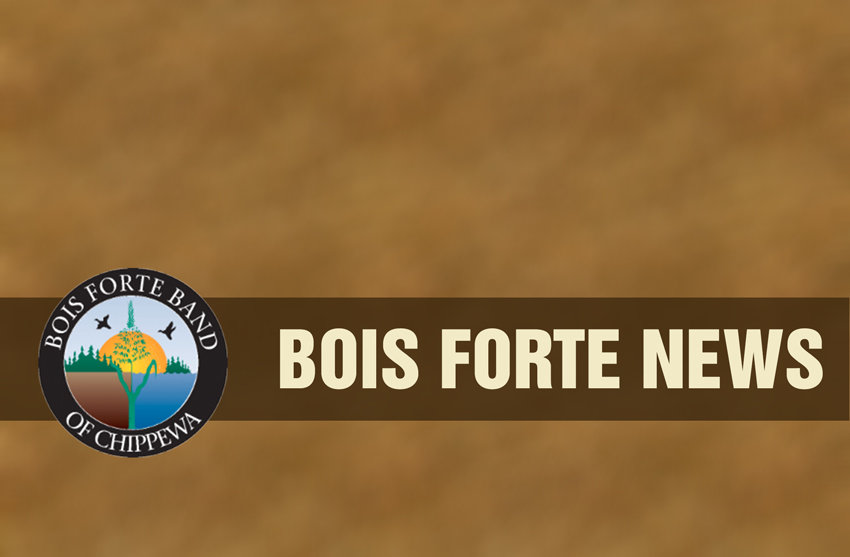Support the Timberjay by making a donation.
Bois Forte launches carbon credit effort
NETT LAKE- A small group of Bois Forte band members came together at the tribal government center in Nett Lake on Tuesday to learn more about the band’s carbon sequestration initiative for 28,000 acres of land from the largest tribal buyback of ancestral lands ever executed in the country.
The 2022 purchase of former PotlatchDeltic lands from The Conservation Fund came with the restriction that the forest land, which is enrolled in the Minnesota Sustainable Forest Incentive Act (SFIA), cannot be used for commercial purposes, but must remain forest-related, ensuring conservation and forest management practices are followed. The incentive payments for enrolling the land in the SFIA program go to pay the loan funds used for the buyback.
“When PotlachDeltic enrolled (the land) in the SFIA program, it’s enrolled for 50 years, so the program for the 28,000 acres will be until 2066,” Bois Forte Tribal Chairwoman Cathy Chavers said.
But working with the National Indian Carbon Coalition, the band has found a way to reap economic benefit from the land without commercial development through the sale of carbon credits for the forested property.
Carbon credits are a means for companies to meet required emissions standards for carbon dioxide and other greenhouse gasses. For example, a company’s operations may emit 43 metric tons of carbon dioxide, but is required to meet a standard of only 40 metric tons of emissions. By purchasing three carbon credits, the company is considered to be in compliance. And carbon credits can act as incentives to reduce emissions, too. Per the example, if the company cuts its emissions of CO2 to 38 metric tons, they can sell two of their carbon credits to someone else.
“We didn’t know what carbon credits were,” Chavers said. “Then along came the National Indian Carbon Coalition (NICC). They asked if we wanted to use our 28,000 acres for carbon credits. So basically, we’re doing economic development. We’re getting money or funding. We’re developing the land (using sustainable management). We’re leaving it as is. The forest will stay the same.”
Chavers said that NICC staff made several trips to review the property to make sure that it was suitable for the carbon credit program and gave credit to the band’s forestry and natural resource staff for their work in facilitating the process.
“We’re the first tribe ever to get this much land back, and we’re nationally known for that,” Chavers said. “Now we’re being nationally recognized for this carbon credit project.”
The band talked with NICC about who they would like to sell their carbon credits to, and they decided to choose more environmentally friendly companies.
“We chose not to go with the gas and oil industries because they harm our environment,” Chavers said. We want to go with industries or companies that are doing good and have the ability to really work out a good partnership with them. We’re kind of going on a new journey, but it will be a good journey, and it will be very beneficial for the future of Bois Forte and for our children in years to come.”
The tribal council has already committed to using SFIA money for natural resources program services, staffing needs, and other support, and Chavers said the carbon credit program will provide extra funds to go toward such activities.
Learning more
NICC Carbon Co-Benefits Director Chase Christopherson had a slide show that explained the program in more detail, but the primary reason he had for being there was community engagement.
“We are a tribal-led program where we work specifically with tribes on exploring and developing really ecosystem-based marketplaces and revenue generation primarily in the carbon market,” Christopherson said. “The reason we’re here today is to do some community outreach, to really meet with all of you to see what you value, what you like, what you don’t like, and really what you would like to be done with this reacquired 28,000 acres. I’m responsible for ensuring that not only are the climate impacts and climate aspects of a carbon project met, but also that the community not only is unaffected by this project activity, but that you benefit from it as well, in addition to the biodiversity of the surrounding areas.”
Toward that end, there were several stations set up in the room, staffed by forestry and natural resources personnel, where attendees were given the opportunity to contribute their goals for forest management, such as facilitating use for traditional tribal activities and biodiversity.
“The plant species, animal species that you want to see either brought back to your lands or that you want to see supported and propagated within these areas.”
Christopherson noted that the project involves collaboration beyond NICC and Bois Forte.
“We are working in partnership with The Nature Conservancy as well as Terra Carbon – they are two nonprofit developers.”
Terra Carbon brings a unique aspect to the project by helping to ensure that it is managed to mitigate climate change, generate social and environmental benefits, and protect biodiversity by following climate, community, and biodiversity standards.
“This is the first type of project done in Indian country in North America,” Christopherson said. “We really have a chance here to show that tribes manage their forest and land (by these standards) but that they do it better than anyone else. I think we’re going to accomplish that.”
Christopherson emphasized that this was just the beginning for getting the community involved, and that NICC would be back numerous times to facilitate more.
Ecological Resources Program Director Chris Holm has been designated as the band’s project lead, and while he had hoped for a larger turnout for Tuesday’s meeting, he said he believes more band members will get involved as they see the band’s commitment to the project and understand the benefits to come from it.
A second session was held on Wednesday for members living in the Vermilion sector.






